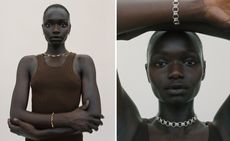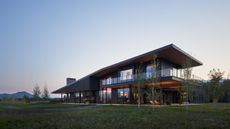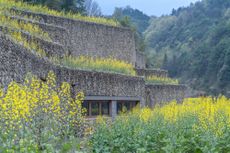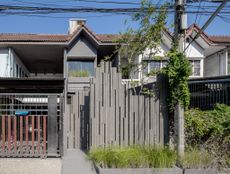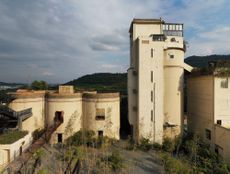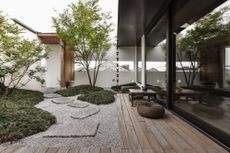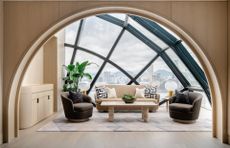At home with Neri & Hu
Architectural super-pair Neri & Hu talk to us about what inspires them, what they are reading, and how they switch off
- (opens in new tab)
- (opens in new tab)
- (opens in new tab)
- Sign up to our newsletter Newsletter
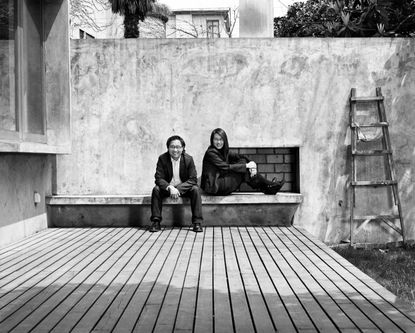
Architecture studio Neri & Hu has been a prominent creative force in the Shanghai built environment scene and beyond, ever since partners in work and life Lyndon Neri and Rossana Hu set up their joint practice in 2004. A recent exhibition at the Aedes Architecture Forum in Berlin neatly sums up their impressive portfolio under its theme, and wider umbrella of 'Reflective Nostalgia'. The two architects, who have worked internationally on anything from urban design, to cultural and hospitality buildings, product design, exhibitions, and more, have been prolific, while crafting their own, unique take on what contemporary architecture can be. Their building designs often bridge old and new – a point the exhibition makes too, looking at some 30 projects from the studio's portfolio. Works such as The Chuan malt whisky distillery and the Aranya Art Center are exemplars of their approach, offering a refined balance of space and materials, past and present, grace and strength. Here, we caught up with Neri & Hu to talk more about their work, life, and current obsessions.

Neri & Hu's exhibition, 'Reflective Nostalgia' at the Aedes Architecture Forum in Berlin, Germany
At home with Neri & Hu
W*: Where are you at the moment? What can you see?
RH: Sitting in my backyard working. I see my newly paved red brick patio, with two abandoned structures that flank my house which needs updating, my neighbours windows, trees, fallen leaves, and a pot of basil that’s probably already dead.
LN: I am back in Shanghai staying in a government mandated quarantine hotel. Day four. Another six days to go. I see the Shanghai skyline with its complexity and contradiction.
W*: What's the last phone call you made?
RH: I talked to my mother in San Diego about her back problem, my work, the war, and political tension we see around the world.
LN: To my parents making sure they are eating properly.

The Chuan malt whisky distillery
W*: The last object you lost? Will you replace it?
RH: Frankly, I may have lost something recently but I don’t yet know what, exactly, since I don’t quite remember what I have and where I keep my things. The last memorable lost item was a gold earring I bought from Paris; it was one of my favourite earrings, and I wore it to a party one night. Returned home very late, and I remember taking it off in bed and putting it in a bamboo box where I keep my tissue paper. I thought that by putting it in the box I would not lose it. However, I completely forgot I placed it in the box, and when I was cleaning a few days later, I took a few tissues to wipe a surface then threw it away. Weeks after, when I was looking for the earring, I realized that I must have thrown it away with the tissue papers. No, I don’t think I will replace it.
LN: My Yohji Yamamoto beanie wool hat. Yes [I'd like to replace it], but probably hard as it is an old model.
W*: Where and when do you find you are most productive?
RH: At night, right before going to bed, my mind is the clearest and my surrounding is the quietest without disturbance. This is when I do the best thinking and writing.
LN: At home and at night.

The Chuan malt whisky distillery
W*: Favourite place, anywhere in the world? And why?
RH: No one favorite place, but it’s where my family is. Right now I am quite enjoying being home in my own house in Shanghai.
LN: Our lane house in the French concession right in the middle of Shanghai. There is a small garden that makes this place special and magical.
W*: What's the one thing (in your creative field) you wish you had designed or invented?
RH: A cemetery.
LN: Paper clip
W*: Ten years from now you'll be…
RH: Teaching and practising architecture, as I am doing now, but have better projects than now, and have more insights to offer my students.
LN: Doing exactly the same but hopefully doing more meaningful and public and community-related projects.

Aranya Art Center
W*: What are you reading, and what do you think of it?
RH: I read many books at once, before finishing with one I move on to others then come back and finish the rest. Right now a fascinating one is a biography of Freud, I picked it up when visiting Freud’s apartment/museum in Vienna a few months ago. Also As I Lay Dying by Faulkner… been on this one for months now.
LN: On Earth We’re Briefly Gorgeous by Ocean Vuong.
W*: What's inspiring you right now?
RH: Chinese art history.
LN: Teaching. We have been teaching both at Harvard and Yale the past four years and it has been reinvigorating to see many young talents.

Aranya Art Center
W*: How do you switch off? Do you switch off?
RH: Music. Especially live concerts. A recent fascination has been TV drama based on historic figures. I feel I’m getting a healthy dosage of pseudo-historic lessons plus intriguing dramatic fabrications.
LN: Meditate on the word of God and pray.
W*: Favourite material to work with and why?
RH: Re-used wood. Natural material that has its own character, personality, individuality, and life.
LN: Brick. The idea that a block of brick can be so basic and simple but can be quite complex and allow many possibilities when combined together and seen as a collective.
W*: What one piece of advice would you give to the next generation?
RH: In everything you do, remember that 'giving is more meaningful than taking'.
LN: Humility is one of the hardest traits to learn but the most powerful force to have for the creative mind.

Lao Ding Feng, Beijing
W*: What's been your biggest failure and what did it teach you?
RH: Hard to identify one thing that’s the biggest failure, but one regret is that when the kids were younger we didn’t spend more time at home because the design office was just starting off and we travelled too much for work during those years. What it teaches me is that time with loved ones is more important than any one project or any important meeting. Keep our eyes on things of eternal value rather than temporary gain is what I keep reminding myself now when I make decisions on how to plan my time.
LN: Not being able to spend as much time with my kids when they were younger. It taught me to treasure my time with them right now.
W*: Who is your dream collaborator?
RH: Artists/architects from different periods of history.
LN: My partner.
W*: If you weren't an architect, what would you have been?
RH: Maybe a teacher or a writer.
LN: Painter.
neriandhu.com (opens in new tab)
Ellie Stathaki is the Architecture Editor at Wallpaper*. She trained as an architect at the Aristotle University of Thessaloniki in Greece and studied architectural history at the Bartlett in London. Now an established journalist, she has been a member of the Wallpaper* team since 2006, visiting buildings across the globe and interviewing leading architects such as Tadao Ando and Rem Koolhaas. Ellie has also taken part in judging panels, moderated events, curated shows and contributed in books, such as The Contemporary House (Thames & Hudson, 2018) and Glenn Sestig Architecture Diary (2020).
-
 Last chance to see: Marc Newson’s all-blue designs in Athens
Last chance to see: Marc Newson’s all-blue designs in AthensGagosian gallery Athens presents new blue furniture and objects by Marc Newson
By Rosa Bertoli • Published
-
 Sapir Bachar’s love for silver makes for abstract jewellery forms
Sapir Bachar’s love for silver makes for abstract jewellery formsSapir Bachar’s fashion background informs her eponymous jewellery brand
By Pei-Ru Keh • Published
-
 Spectacular Wyoming ranch sits within a restored working landscape
Spectacular Wyoming ranch sits within a restored working landscapeThis Wyoming ranch by CLB Architects offers a new approach to the Western architectural tradition, combining daring and functional modern design with a welcoming character
By Jonathan Bell • Published
-
 China’s Qingxi Culture and History Museum draws on its surrounding land
China’s Qingxi Culture and History Museum draws on its surrounding landQingxi Culture and History Museum by UAD is a cultural destination in China designed in harmony with its surroundings
By Ellie Stathaki • Last updated
-
 HAS Design + Research, Thailand and China: Wallpaper* Architects’ Directory 2022
HAS Design + Research, Thailand and China: Wallpaper* Architects’ Directory 2022Wallpaper* Architects’ Directory is our annual round-up of exciting emerging architecture studios. Next up, is Thailand- and China-based HAS Design + Research
By Ellie Stathaki • Last updated
-
 A multi-functional event space by Wutopia Lab celebrates daily life in the city
A multi-functional event space by Wutopia Lab celebrates daily life in the cityA Living Theatre Mount by Wutopia Lab is an exhibition, meeting and event space for developer Xuzhou Vanke in China's Jiangsu province
By Ellie Stathaki • Last updated
-
 Open architecture on building and China’s cultural landscape
Open architecture on building and China’s cultural landscapeOpen Architecture’s perfectly considered projects either disappear into the landscape or become new landmarks
By Yoko Choy • Last updated
-
 A Chinese industrial building transformation makes for a minimalist live/work space
A Chinese industrial building transformation makes for a minimalist live/work spaceThe renovation of an abandoned cement factory on the southeastern coast of China by designer Wanmu Shazi resulted in a minimalist and calming live/work space
By Ellie Stathaki • Last updated
-
 Heatherwick Studio’s 1000 Trees blooms in Shanghai
Heatherwick Studio’s 1000 Trees blooms in ShanghaiHeatherwick Studio’s 1000 Trees is Shanghai’s newest mixed-use development, blending trees, art and sculptural concrete
By Nick Compton • Last updated
-
 Villa in Xitang’s Ancient Town blends luxury and Chinese vernacular architecture
Villa in Xitang’s Ancient Town blends luxury and Chinese vernacular architectureVilla in Xitang Ancient Town is the latest hospitality complex in the historic water town of the Jiangnan region in southern China, courtesy of Nature Times Art Design Co
By Ellie Stathaki • Last updated
-
 Rare views and light colours define this Hong Kong family office redesign
Rare views and light colours define this Hong Kong family office redesignBrewin Design Office redesigns penthouse family office for Shui On Land in Hong Kong, featuring rare views and light colours
By Daven Wu • Last updated

